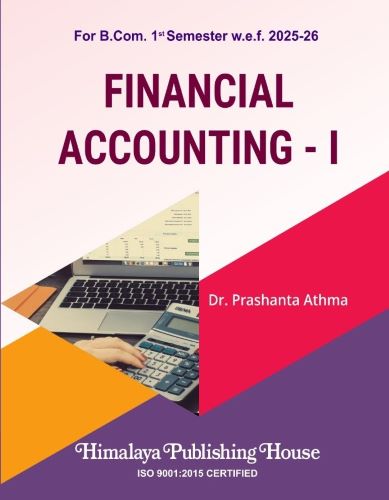The book on “Financial Accounting-I” is tailor-made to meet the requirements of contents of the new syllabi of B.Com I Semester (CBCS) of the Universities in Telangana and also provide requisite knowledge in Accounting.
An earnest and sincere attempt is made to present the information in a non-technical, simple and lucid manner so as to enable the reader to understand the subject with ease.
The book contains sufficiently a large number of illustrations for a better grasp in the subject matter. Wherever necessary, working notes and explanations have been provided.
At the end of each Chapter, questions and problems are given for practice.
Contents –
1. Accounting Process
1.1 Financial Accounting: Introduction
1.2 Financial Accounting: Definition
1.3 Financial Accounting: Evolution
1.4 Financial Accounting: Functions
1.5 Financial Accounting: Advantages
1.6 Financial Accounting: Limitations
1.7 Users of Accounting Information
1.8 Branches of Accounting
1.9 Accounting Principles
1.9.1 Concepts
1.9.2 Conventions
1.10 Accounting Standards: Meaning
1.11 Accounting Standards: Importance
1.12 Accounting Standards: List issued by ASB
1.13 Ind AS
1.14 Accounting System
1.15 Types of Accounts
1.16 Accounting Cycle
1.17 Summary
1.18 Glossary
1.19 Questions
2. Journal
2.1 Meaning of Journal
2.2 Importance of Journal
2.3 Rulings of Journal
2.4 Double Entry System of Accounting
2.5 Compound Journal Entry
2.6 Summary
2.7 Glossary
2.8 Questions
2.9 Problems
3. Ledger
3.1 Meaning of Ledger
3.2 Format of a Ledger Account
3.3 Meaning of Ledger Posting
3.4 Posting the Opening Entry
3.5 Closing and Balancing of Ledger Accounts
3.6 Usage of To and By
3.7 Methods of Closing Various Types of Accounts
3.8 Journal and Ledger Relationship
3.9 Summary
3.10 Glossary
3.11 Questions
3.12 Problems
4. Trial Balance
4.1 Meaning of Trial Balance
4.2 Objectives of Drawing up a Trial Balance
4.3 Defects of a Trial Balance
4.4 Methods of Preparing the Trial Balance
4.5 Rules for Preparing the Trial Balance
4.6 Types of Errors
4.6.1 Clerical Errors
4.6.2 Errors of Principle
4.7 Errors Disclosed by the Trial Balance
4.8 Errors Not Disclosed by the Trial Balance
4.9 Locating Errors
4.10 Correcting the Errors
4.11 Suspense Account
4.12 Summary
4.13 Glossary
4.14 Questions
4.15 Problems
5. Subsidiary Books
5.1 Meaning of Subsidiary Book
5.2 Types of Subsidiary Books
5.3 Purchases Book
5.4 Purchase Returns Book
5.5 Sales Book
5.6 Sales Returns Book
5.7 Bills Receivable
5.8 Bills Payable Book
5.9 Cash Book
5.9.1 Simple Cash Book
5.9.2 Two Column Cash Book
5.9.3 Contra Entry
5.9.4 Three Column Cash Book
5.10 Petty Cash Book
5.10.1 Analytical Petty Cash Book:
5.10.2 Imprest System
5.11 Journal Proper
5.12 Summary
5.13 Glossary
5.14 Questions
5.15 Problems
6. Rectifiction of Errors
6.1 Introduction
6.2 Capital vs. Revenue Expenditure
6.3 Capital Vs Revenue Receipts
6.4 Deferred Revenue Expenditure
6.5 Errors and their Rectification
6.6 Types of Errors
6.6.6 Clerical Errors
6.67 Errors of Principle
6.7 Errors Disclosed by the Trial Balance
6.8 Errors not Disclosed by the Trial Balance
6.9 Rectification of One Sided Errors
6.9.1 Posting Wrong Amount
6.9.2 Omission of Entry in the Ledger Account
6.9.3 Posting the Amount on the Wrong Side
6.9.4 Posting the Same Amount Twice in the Account
6.9.5 Wrong Totalling or Casting
6.9.6 Wrong Balancing of the Ledger Accounts
6.9.7 Errors in Carrying Forward or Bringing Forward
6.9.8 Omission to Post the Amount in the Trial Balance
6.10 Rectification of Two Sided Errors
6.10.1 Error of Omission
6.10.2 Error of Commission
6.10.3 Error of Principle
6.10.4 Posting to Wrong Heads of Account
6.10.5 Compensating Errors
6.11 Suspense Account
6.12 Rectification of Errors through Suspense Account (After the Preparation of Trial Balance)
6.13 Effect of Errors on Profit and Loss Account (After the Preparation of the Final Accounts)
6.14 Summary
6.15 Glossary
6.16 Questions
6.17 Problems
7. Bank Reconciliation Statement
7.1 Meaning of Bank Reconciliation Statement
7.2 Need
7.3 Cash Book vs. Passbook
7.4 Favourable Balance: BRS
7.5 Unfavourable Balance (Overdraft): BRS
7.6 Cash Book and Passbook with Same Period: BRS
7.7 Cash Book and Passbook with Different Period: BRS
7.8 Amended Cash Book
7.9 Summary
7.10 Glossary
7.11 Questions
7.12 Problems
8. Depreciation Accounting
8.1 Depreciation (Ind AS -16)
8.2 Definition
8.3 Meaning
8.4 Causes for Depreciation
8.5 Certain Concepts
8.6 Objectives of Providing Depreciation
8.7 Factors Affecting Depreciation
8.8 Accounting Treatment of Depreciation
8.9 Methods of Depreciation
8.9.1 Straight Line Method
8.9.2 Diminishing Balance Method (or Reducing Balance Method)
8.9.3 Sum of the Units Method
8.10 Effect of Depreciation
8.11 Summary
8.12 Glossary
8.13 Questions
8.14 Problems
9. Final Accounts of Sole Trader
9.1 Final Accounts: Meaning
9.2 Final Accounts: Uses
9.3 Trading Account
9.3.1 Explanation to Certain Items
9.4 Manufacturing Account
9.5 Profit and Loss Account
9.6 Balance Sheet
9.7 Adjustments
9.7.1 Depreciation
9.7.2 Bad Debts
9.7.3 Provision for Bad and Doubtful Debts
9.7.4 Provision for Discount on Debtors
9.7.5 Provision for Discount on Creditors
9.7.6 Oustanding Expenses
9.7.7 Prepaid Expenses
9.7.8 Income Earned but Not Received
9.7.9 Unearned Income
9.7.10 Interest on Capital
9.7.11 Interest on Drawings
9.7.12 Loss of Stock by Fire/Theft
9.7.13 Closing Stock
9.7.14 Interest on Loan
9.7.15 Charity and Samples
9.7.16 Goods used for Personal Purpose
9.7.17 Manager’s Commission on Net Profit
9.7.18 Dishonour of Bills Receivable received from Debtors
9.7.19 Dishonour of Cheque Received from Debtors
9.7.20 Credit Purchase of a Machine
9.7.21 Installation Charges of a Machine
9.8 Closing Entries
9.9 Summary
9.10 Glossary
9.11 Questions
9.12 Problems







